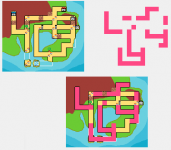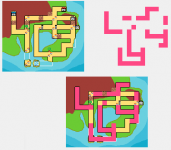Hi, I have a problem drawing in a PictureBox.
To summarize and make an example: imagine you have to draw a rectangle at 0, 0 and it's 100x100 pixels; then you have to draw another rectangle 10x10 at the center (which should be at 45, 45 if i'm not mistaken) but the result shall be simply the first rectangle...meaning they both get drawn, you just can't distinguish them (or maybe you can find a way to say "if some of the second shape overlaps the first, don't draw the overlapping part).
Basically, i have to draw in the picturebox with a brush and first I create a region to specify where it shall be drawn and where not.
I have a system in a dictionary to pick up coordinates and dimensions of various rectangles. First of all, in the paint event of the picturebox, i create a graphicspath. Then what i do cyclically is:
- go and pick data for the rectangle, to create it
- i add the rectangle to the graphicspath
Then with the graphicspath created and made with every single rectangle, i state that picturebox.region = new region(graphicspath). It DOES work generally speaking.
MAIN PROBLEM IS: when i get to add and draw rectangles that overlap, in the overlap area they just don't get drawn (but the remaining shape of these rectangles does remain drawn), concretely speaking that area becomes "transparent" (as if not drawn).
I don't understand if this problem goes for the graphicpath or for the region and how to avoid it. Someone adviced me to read about Region class methods but the only methods that seemed to fit (union, intersect and complement) worsen the problem. If i cyclically create a graphicspath, with the given rectangle, and then go for region.complement(graphicspath) (and remember, in this second hypothetic case this is a cycle, so next step will be to recreate a graphicspath to complement in the region), at the end what i get is the picturebox gets for region its full space/dimensions.
I spent hours to search and try solutions, so i really hope you can give me some help or concrete direction.
Edit:
I added an image. Basically the second pic you see (the pink lines) should blink above the map on the left, as you see in the 3rd pic. It blinks, that's just fine. Problem is, for now, it doesn't blink like that, instead (following suggestions here below) it blinks pic1/pic2 and repeat. At the beginning instead, when i got transparent overlaps, it blinked exactly like in the pic3, but yeah, overlapped region became transparent as well.
The way this blink is activated is through a Timer, whenever it is activated (interval 500) it loops back and forth. What i forgot to mention and this may be crucial, is that the blink region is another picture box aside that map. In fact, one picturebox contains the image map, the other picturebox is located over the first and what the Timer does cyclically is:
if (evidenziapunti.visible == true) { evidenziapunti.visible = false; } else { evidenziapunti.visible = true; }
To summarize and make an example: imagine you have to draw a rectangle at 0, 0 and it's 100x100 pixels; then you have to draw another rectangle 10x10 at the center (which should be at 45, 45 if i'm not mistaken) but the result shall be simply the first rectangle...meaning they both get drawn, you just can't distinguish them (or maybe you can find a way to say "if some of the second shape overlaps the first, don't draw the overlapping part).
Basically, i have to draw in the picturebox with a brush and first I create a region to specify where it shall be drawn and where not.
I have a system in a dictionary to pick up coordinates and dimensions of various rectangles. First of all, in the paint event of the picturebox, i create a graphicspath. Then what i do cyclically is:
- go and pick data for the rectangle, to create it
- i add the rectangle to the graphicspath
Then with the graphicspath created and made with every single rectangle, i state that picturebox.region = new region(graphicspath). It DOES work generally speaking.
MAIN PROBLEM IS: when i get to add and draw rectangles that overlap, in the overlap area they just don't get drawn (but the remaining shape of these rectangles does remain drawn), concretely speaking that area becomes "transparent" (as if not drawn).
I don't understand if this problem goes for the graphicpath or for the region and how to avoid it. Someone adviced me to read about Region class methods but the only methods that seemed to fit (union, intersect and complement) worsen the problem. If i cyclically create a graphicspath, with the given rectangle, and then go for region.complement(graphicspath) (and remember, in this second hypothetic case this is a cycle, so next step will be to recreate a graphicspath to complement in the region), at the end what i get is the picturebox gets for region its full space/dimensions.
I spent hours to search and try solutions, so i really hope you can give me some help or concrete direction.
Edit:
I added an image. Basically the second pic you see (the pink lines) should blink above the map on the left, as you see in the 3rd pic. It blinks, that's just fine. Problem is, for now, it doesn't blink like that, instead (following suggestions here below) it blinks pic1/pic2 and repeat. At the beginning instead, when i got transparent overlaps, it blinked exactly like in the pic3, but yeah, overlapped region became transparent as well.
The way this blink is activated is through a Timer, whenever it is activated (interval 500) it loops back and forth. What i forgot to mention and this may be crucial, is that the blink region is another picture box aside that map. In fact, one picturebox contains the image map, the other picturebox is located over the first and what the Timer does cyclically is:
if (evidenziapunti.visible == true) { evidenziapunti.visible = false; } else { evidenziapunti.visible = true; }
Attachments
Last edited:



